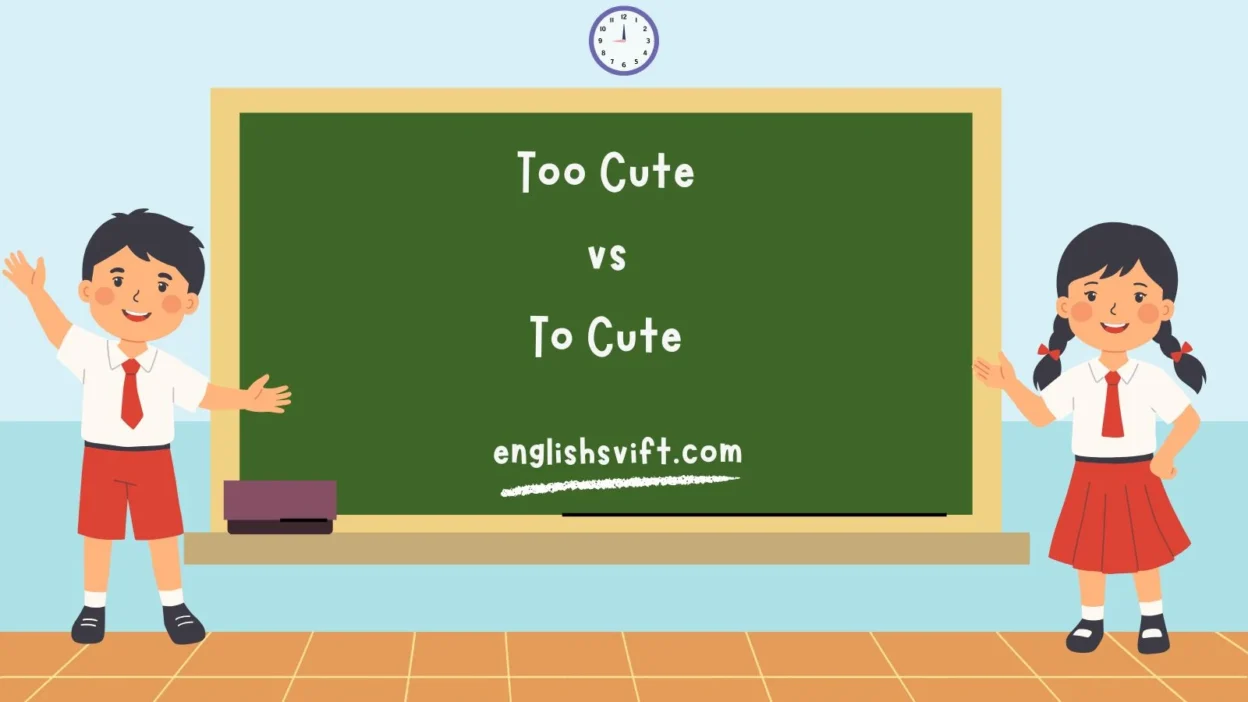We’ve all been there — scrolling through social media, someone posts a puppy in oversized shoes, and the comments section floods with “Too cute!”.
But every now and then, you’ll spot a rogue “To Cute” sneaking in, and it just… doesn’t look right.
So, what’s the deal? Why does one version feel heartwarming and grammatically correct, while the other feels like it tripped over a misplaced letter?
In this guide, we’ll break down the difference between “Too Cute” and “To Cute”, explore their meanings, contexts, grammar rules, and show you how to use them accurately in conversations, writing, and even in those adorable Instagram captions.
Understanding the Difference Between Too Cute and To Cute
The short answer?
- Too Cute ✅ = Grammatically correct, means excessively adorable.
- To Cute ❌ = Grammatically incorrect in almost all cases.
| Phrase | Grammar Role | Meaning | Correct? | Example |
| Too Cute | Adverb + Adjective | More adorable than normal; excessively charming | ✅ | That kitten is too cute to resist. |
| To Cute | Preposition + Adjective | No logical meaning in standard English | ❌ | Incorrect: That puppy is to cute. |
What Does Too Cute Mean?
Too cute is an expression that combines:
- Too → an adverb meaning “excessively” or “more than is desirable/expected.”
- Cute → an adjective meaning “adorable,” “charming,” or “attractive in a sweet way.”
Example:
Her giggle was too cute — I couldn’t stop smiling.
Here, “too” amplifies “cute” to imply beyond the normal level of cuteness.
Grammar Rules for Using Too as an Adverb
When too is an adverb, it’s placed before adjectives or adverbs to indicate excessiveness.
| Correct Structure | Example | Meaning |
| Too + Adjective | Too cute | Excessively adorable |
| Too + Adverb | Too quickly | More quickly than desired |
| Too + Much/Many + Noun | Too many cookies | More than is acceptable |
Rule Reminder:
- Use too when you want to emphasize a degree of something.
- If you’re heading toward a place, that’s when you use to (different function entirely).
Common Contexts Where Too Cute Fits Naturally
“Too cute” works best when describing:
| Context | Example |
| Pets | The puppy’s tiny paws were too cute to handle. |
| Babies | That toddler’s oversized hat is too cute. |
| Objects | That teacup set is too cute for words. |
| Clothing | Her panda sweater is just too cute. |
| Moments | Their anniversary dance was too cute to watch without tearing up. |
Emotional Impact of Saying “Too Cute”
When you say “too cute,” you’re doing more than pointing out attractiveness — you’re expressing an emotional reaction.
It often conveys:
- Admiration (I love this)
- Affection (It warms my heart)
- Overwhelm (It’s almost too much to handle)
Example:
That kitten curled up in a ball? Too cute — my heart can’t take it.
Too Cute in Everyday Conversations and Social Media
Social media loves hyperbole, and “too cute” thrives there:
- Instagram captions → “My nephew’s first day of school 🥹 too cute!”
- TikTok comments → “Stop, this is too cute for my eyes.”
- Text messages → “Omg, your dog is too cute 🐾.”
It’s become part of modern vernacular — a casual, positive, and lighthearted phrase.
Examples of Too Cute in Sentences
| Sentence | Context |
| Her smile is too cute for words. | Complimenting a person |
| That baby panda is too cute to resist. | Describing an animal |
| These cupcakes are too cute to eat. | Talking about objects |
| Your puppy is too cute when he tilts his head. | Everyday conversation |
| The couple’s matching sweaters are too cute. | Social interaction |
What Does To Cute Mean? (And Why It’s Usually Incorrect)
“To cute” doesn’t work in standard English grammar because:
- To is a preposition (shows direction, place, or purpose).
- Cute is an adjective.
When combined, they don’t form a meaningful structure unless part of a larger sentence like:
I’m going to cute this paper into a heart shape. (Here, “cute” is incorrectly used as a verb — still wrong in meaning.)
To as a Preposition – Definition and Uses
To is used for:
- Direction (I’m going to the mall.)
- Purpose (I study to improve my skills.)
- Intention (She waved to him.)
| Function | Example | Meaning |
| Direction | Go to the park. | Movement toward |
| Purpose | He studies to pass. | Goal |
| Recipient | Give it to her. | Target of action |
Grammar Errors That Lead to “To Cute” Mistakes
People mix up “too” and “to” because they’re homophones — they sound the same.
Common causes:
- Typing quickly (typos)
- Auto-correct replacing “too” with “to”
- Not knowing the degree vs direction rule
Real-Life Examples of Misusing “To Cute”
| Incorrect Sentence | Corrected Sentence |
| Your kitten is to cute. | Your kitten is too cute. |
| That video is to cute for me. | That video is too cute for me. |
| She’s to cute in that dress. | She’s too cute in that dress. |
Comparing Too Cute and To Cute Side-by-Side
| Feature | Too Cute | To Cute |
| Grammar Role | Adverb + Adjective | Preposition + Adjective |
| Correct? | ✅ Yes | ❌ No |
| Meaning | Excessively adorable | No clear meaning |
| Common Use | Social media, conversations, compliments | Typos, misunderstandings |
Synonyms and Alternatives for Too Cute
| Synonym | Tone | Example |
| Adorable | Warm | That puppy is adorable. |
| Charming | Gentle | Her smile is charming. |
| Precious | Emotional | Your baby is precious. |
| Irresistible | Strong | Those kittens are irresistible. |
| Endearing | Sweet | His laugh is endearing. |
Situations Where “Too Cute” Might Sound Exaggerated
Sometimes, “too cute” can feel over the top — especially in formal writing.
In those cases, you might choose:
- “Very cute”
- “Quite charming”
- “Adorably sweet”
Tone and Sentiment Differences in Each Phrase
- Too Cute → Warm, emotional, informal, affectionate.
- To Cute → Feels like a spelling mistake or grammar slip.
Social Media Trends: Why Too Cute Dominates Over To Cute
A quick scroll on Instagram, TikTok, or Reddit shows:
- “Too cute” → Thousands of hashtag uses.
- “To cute” → Mostly appears in corrections or jokes.
How Native Speakers Naturally Use Too Cute
Native speakers often use “too cute” in:
- Compliments (You look too cute today!)
- Teasing affection (That’s too cute, stop it.)
- Storytelling (When she gave me the note, it was too cute.)
Tips to Avoid Confusing Too and To
- Remember: Too = extra, To = toward.
- If you can replace it with “very,” use too.
- Proofread captions before posting.
Memory Tricks to Remember the Difference
- Too has an extra “o” for “extra” meaning.
- Think: Too = Over the top.
Fun Idioms and Expressions Related to Cuteness
- Cute as a button
- Melts my heart
- Puppy dog eyes
Animal and Baby Examples for “Too Cute” Usage
| Example | Subject |
| The hedgehog curled into a ball is too cute. | Animal |
| Her toddler’s giggle is too cute. | Baby |
| That sloth hanging from a branch is too cute. | Animal |
Using Too Cute in Writing vs. Speech
- Writing → More deliberate, often in social posts or casual notes.
- Speech → Quick, emotional reaction.
Common Homophone Confusions: Too, To, and Two
| Word | Meaning | Example |
| Too | Excessively, also | Too cute |
| To | Direction, purpose | Go to the park |
| Two | Number 2 | Two kittens |
Grammar Checklist for Proofreading Cute-Related Sentences
✅ Check if “too” means “excessively.”
✅ Make sure “to” shows movement or purpose.
✅ Avoid typos.
Final Thoughts on Mastering Too vs To
Once you know the function of “too” vs “to”, it’s easy to spot mistakes.
Use too cute when you mean excessively adorable.
Avoid “to cute” unless you’re intentionally breaking grammar rules for humor.
FAQs
Q1: Is “too cute” ever wrong?
Only in extremely formal contexts — otherwise, it’s fine in casual speech/writing.
Q2: Can “to cute” be correct in any sentence?
Not in standard English; it’s usually a typo.
Q3: Why do people mix them up?
They’re homophones and look similar when typed quickly.
Q4: Are “too” and “very” the same?
Similar, but “too” often implies excess beyond what’s desirable.
Q5: How can I remember the difference?
Think of the extra “o” in “too” as “over the top.”



